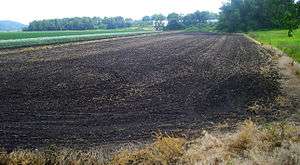Chernozem
| Chernozem | |
|---|---|
| Chernozemic soil | |
 | |
| Chernozem field in Black Dirt Region of Orange County, New York, United States | |
| Used in: | WRB, other |
| WRB code: | CH |
| Profile: | AhBC |
| Parent material: | Loess |
| Climate: | Humid continental |
Chernozem (from Russian: чернозём, tr. chernozyom; IPA: [tɕɪrnɐˈzʲɵm] or Ukrainian: чорнозем, translated as "black soil, dirt or earth") is a black-coloured soil containing a high percentage of humus[1] (7% to 15%), and high percentages of phosphoric acids, phosphorus and ammonia. Chernozem is very fertile and produces a high agricultural yield.
Distribution
There are two "Chernozem belts" in the world: from eastern Croatia (Slavonia), along the Danube (northern Serbia, northern Bulgaria (Danubian Plain), southern Romania (Wallachian Plain) and Moldova) to northeast Ukraine across the Black Earth Region and southern Russia into Siberia, and the other in the Canadian Prairies in Manitoba. Similar soil types occur in Texas and Hungary. Chernozem layer thickness may vary widely, from several inches up to 60 inches (1.5 metres) in Ukraine.[2]
The terrain can also be found in small quantities elsewhere (for example, on 1% of Polish territory). It also exists in Northeast China, near Harbin. The only true chernozem in Australia is located around Nimmitabel producing some of the richest soils in the nation.[3]
The sale of agricultural land has been illegal in Ukraine since 1992; despite this, there is a black market for chernozem soil, transported by the truckload, with approximately $900 million in annual sales.[4]
Canadian and United Nations soil classification
Chernozemic soils are a soil type in the Canadian system of soil classification and the United Nations' FAO soil classification.
| Chernozemic soil type equivalents, in Canadian, FAO, and USA soil taxonomy | ||
| Canadian | FAO | United States |
|---|---|---|
| Chernozemic | Kastanozem, Chernozem, Greyzem, Phaeozem | Borolls |
| Brown Chernozem | Kastanozem (aridic) | Aridic Boroll subgroups |
| Dark Brown Chernozem | Kastanozem (Haplic) | Typic Boroll subgroups |
| Black Chernozem | Chernozem | Udic Boroll subgroups |
| Dark Grey Chernozem | Greyzem | Boralfic Boroll subgroups, Albolls |
| Source: Pedosphere.com. |
History
Theories of chernozem origin:
- 1763 — Mikhail Lomonosov (plant and animal decomposition)[5]
- 1799 — Peter Simon Pallas (reeds marsh)
- 1835 — Charles Lyell (loess)[6]
- 1840 — Sir Roderick Murchison (weathered from Jurassic marine shales)[6]
- 1850 — Karl Eichwald (peat)
- 1851 — А. Petzgold (swamps)
- 1852 — Nikifor Borisyak (peat)
- 1853 — Vangengeim von Qualen (silt from northern swamps)
- 1862 — Rudolf Ludwig (bog on place of forests)
- 1866 — Franz Josef Ruprecht (decomposed steppe grasses) [7]
- 1879 — First chernozem papers translated from Russian[8]
- 1883 — Vasily Dokuchaev published book "Russian Chernozem" with complete study of this soil in European part of Russia.[9]
- 1929 — Otto Schlüter (man-made)[10]
- 1999 — Michael W.I Schmidt (ancient biomass burning)[10][11][12]
See also
References
- ↑ "chernozem". Merriam-Webster Online Dictionary. 2008. Retrieved 2008-07-07.
- ↑ Ukraine: Soils in Encyclopedia Britannica
- ↑ KG McQueen "The Tertiary Geology And Geomorphology Of The Monaro: The Perspective In 1994" Centre For Australian Regolith Studies, Canberra 1994
- ↑ Black market for black earth, Kyiv Post (9 November 2011)
- ↑ Lomonosov M. V. § 125. // On the strata of the Earth: a translation of “O sloiakh zemnykh” (1763) / translated by S. M. Rowland, S. Korolev. Boulder: Geological Soc. of America, 2012. 41 p. (Special paper; 485) "And so, there is no doubt that black soil is not primordial matter, but that it has been produced by the decomposition of animal and plant bodies over time"
- 1 2 Geikie, A. (1875), Life of Sir Roderick I, Murchison 1, ASIN B0095632AU
- ↑ Fedotova, Anastasia A. (August 2010), "The Origins of the Russian Chernozem Soil (Black Earth): Franz Joseph Ruprecht's 'Geo-Botanical Researches into the Chernozem' of 1866", Environment and History (White House Press) 16 (3): 271–293
- ↑ Dokoutchaief B. Tchernozème (terre noire) de la Russie d'Europe. St.-Ptb.: Soc. Imp. libre économ., 1879. 66 p. (Comptes-rendus Soc. Imp. libre économ. T. 4).
- ↑ Dokuchaev V. V. Russian Chernozem (1883) // Israel Program for Scientific Translations Ltd. (for USDA-NSF), S. Monson, Jerusalem, 1967. (Translated from Russian into English by N. Kaner)
- 1 2 Eckmeier, Eileen; Gerlach, Renate; Gehrt, Ernst; Schmidt, Michael W.I. (2007), "Pedogenesis of Chernozems in Central Europe — A review" (PDF), Geoderma (Elsevier B.V.) 139: 288–299, doi:10.1016/j.geoderma.2007.01.009
- ↑ Schmidt, M.W.I.; Skjemstad, J.O.; Jäger, C. (2002), "Carbon isotope geochemistry and nanomorphology of soil black carbon: Black chernozemic soils in central Europe originate from ancient biomass burning", Global Biogeochemical Cycles 16 (4), doi:10.1029/2002GB001939,
These data challenge the common paradigm that chernozems are zonal soils with climate, parent material and bioturbation dominating soil formation, and introduce fire as a novel, important factor in the formation of these soils
- ↑ Eckmeier, E. (2007), Detecting prehistoric fire-based farming using biogeochemical markers, University of Zurich, Faculty of Science., doi:10.5167/uzh-3752,
It is now an open question as to whether Neolithic settlers did indeed prefer to grow crops where Chernozems occurred or if Neolithic burning formed the chernozemic soils.
External links
| Wikimedia Commons has media related to Chernozem. |
![]() The dictionary definition of chernozem at Wiktionary
The dictionary definition of chernozem at Wiktionary